|
The new crop
picture at Ackling Dyke on June 4, 2018 resembles a scene from a movie
called “The Arrival” (2016). Will “alien heptapods” really come soon to
Earth, or is this just a clever joke by the crop artists? And if a real
“arrival” of friendly aliens on Earth is planned for the near-future,
can we tell by studying the details of this crop picture, when exactly
that might be?
A new crop
picture at Ackling Dyke on June 4, 2018 shows a “seven-pointed star”,
with “small round jewels” and Aztec-Mayan symbols for “calendar time”
around the outside:
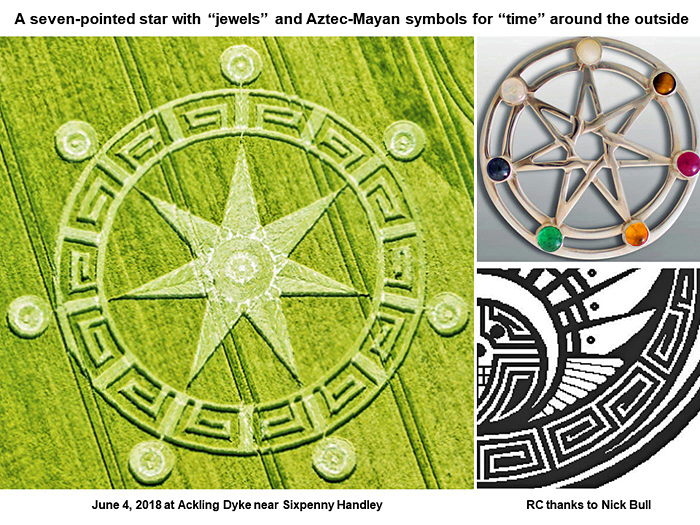
Each of
those Aztec-Mayan symbols seems to represent one year of 360 days, or a
“tun” in their Long Count calendar. We can tell the exact meaning of
those symbols, by comparing with similar symbols drawn around the
outside of the “Quetzalcoatl Headdress” on July 5, 2009 (inset at lower
right in the slide shown above).
This crop
picture also seems to represent a comical parody of a science-fiction
movie from 2016 called “The Arrival”. In that movie, “alien heptapods”
(somewhat like highly-evolved octopuses) come to Earth in a fleet of
large spaceships. Then they try to communicate with humans on Earth, by
spraying highly-patterned “ink circles” out of the seven-pointed
tendrils which they use for “hands” (see
www.youtube.com or
-arrival-movie-alien-language-explained):
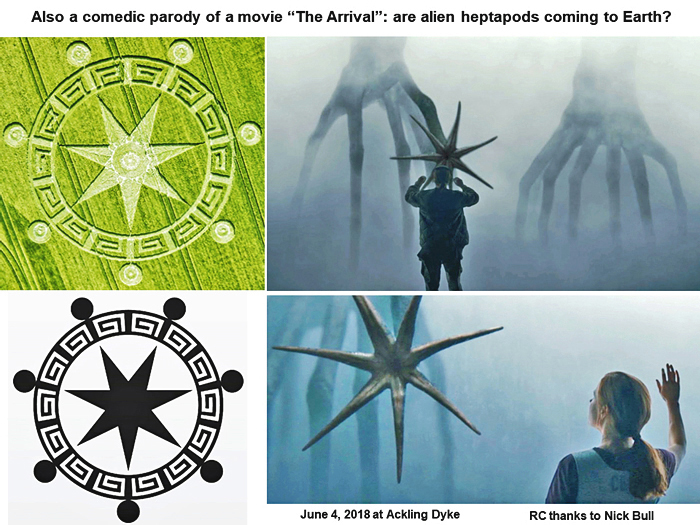
Ha, ha, what
a clever joke! Some relation to the real “crop circle” phenomenon
perhaps?
Now if
actual extra-terrestrials plan to arrive soon on Earth, and thereby
create a real “Arrival” of their own, can we tell by studying the
complex details of this crop picture, and its surrounding landscape
features, when exactly that might be?
This crop
picture seems to show a “calendar sundial”, in which certain shadows
from the rising or setting Sun (each low in the sky near the horizon)
help us to read a “calendar time” in years or Aztec-Mayan “tuns”.
Two previous
crop pictures at White Way on June 2, or Bishop Cannings Down on June 3,
even included certain subtle patterns of standing crop, which marked an
approximate 240o angle along the horizon, which is the angle
between where our Sun rises and sets in southern England close to any
summer solstice.
Reading the
new “calendar wheel” which was drawn in crops at Ackling Dyke on June 4,
2018: how long will it be until a real “arrival” of friendly
extra-terrestrials on Earth?
This crop
picture looks somewhat like the centre of the famous “Aztec calendar
stone” (see
Aztec_calendar_stone), and shows 2 x 7 Mayan-Aztec symbols for
“tuns” or 360-day years around the outside. How can we read the intended
calendar date or interval of time, which has been cleverly encoded
there?
First we
might note that the outer parts of this crop picture point to a small
landscape feature on the left, which resembles the crop picture in
certain ways (outlined in yellow):
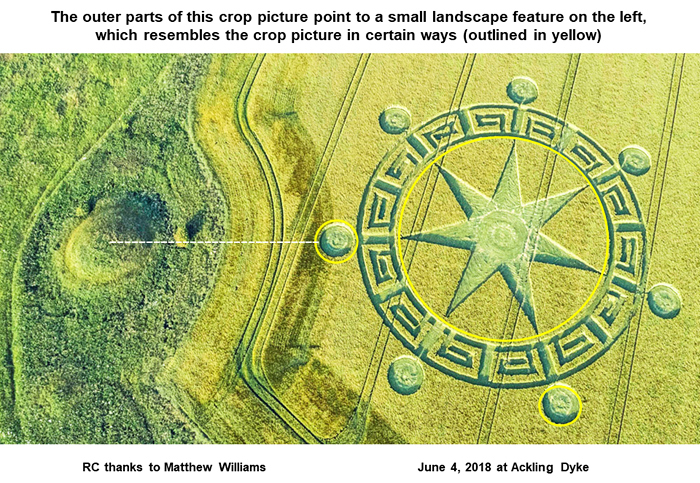
Next if we
rotate this “calendar wheel” clockwise by three places, then two of its
outer “balls” (outlined in yellow) will align themselves nicely, with
similar small “dots” in the landscape on the left:
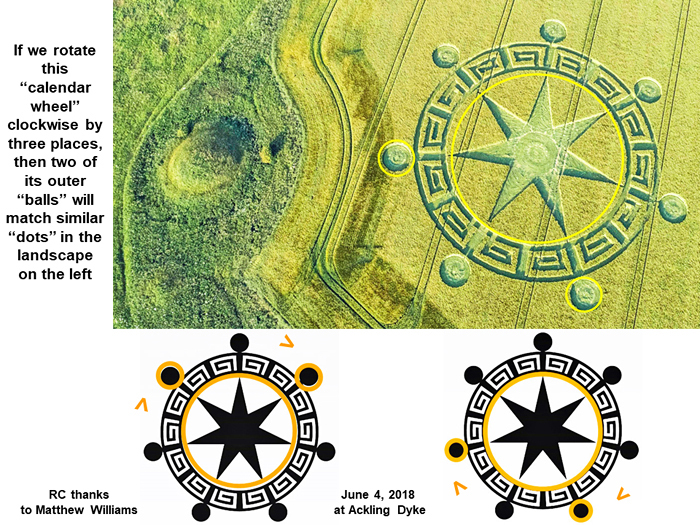
How do we
know which two “balls” to choose for our analysis? Well, if we study the
excellent drone photographs of Matthew Williams or Nick Bull, we can see
that long shadows from the morning Sun (in the east) produce two small
squares or “dots” in the lower left part of this crop picture:
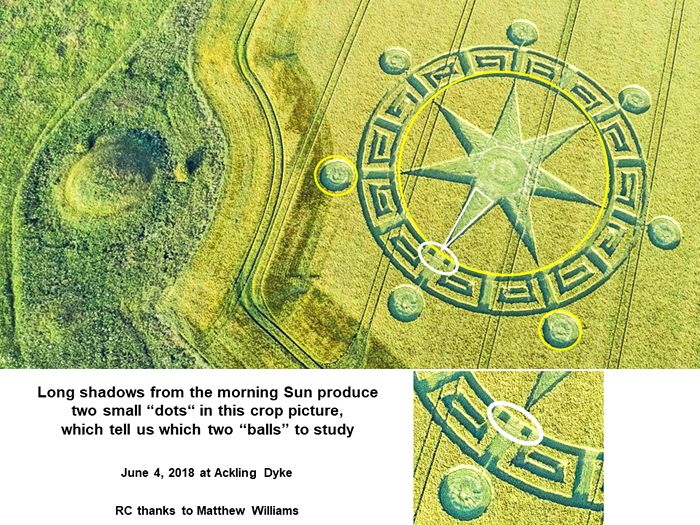
Those two
small “dots” (outlined in white) tell us which two outer “balls” to
study, as one on the left and another on the right (outlined in yellow):
An
alternative solution, where we might rotate clockwise by just one place
(from the first yellow “ball” which points toward that landscape feature
on the left), would not seem consistent with such “shadow” features. It
would also seem unduly trivial to encode a one-place-rotation of just 51o,
within a much-larger “calendar wheel” for which seven different
rotational settings are available.
The use of
long shadows from our Sun, to produce specific images in the landscape,
was quite common in Mayan times, for example to produce images of a
“serpent descending” on the spring or autumn equinoxes, at the Pyramid
of Kukulkan in Chichen Itza.
Three
Aztec-Mayan years or “tuns” seems to be the suggested interval of time
from 2018 to 2021
In summary,
the period of time suggested by this new crop picture, until a real
“arrival” of friendly extra-terrestrials on Earth, would seem to be
three Aztec-Mayan “tuns”, or approximately three solar years from
2018 to 2021.
There is
also an outside possibility that they mean six Aztec-Mayan “tuns” from
2018 to 2024, if we count six rotating symbols for “tun”, rather than
three rotating outer “balls”, to give the same landscape alignment as
shown.
In the broad
landscape nearby, we can see the image of an “alien heptapod” with a
“serpent face”, who seems to be “counting his steps” using a “pedometer”
(the new crop picture) until he reaches Earth!
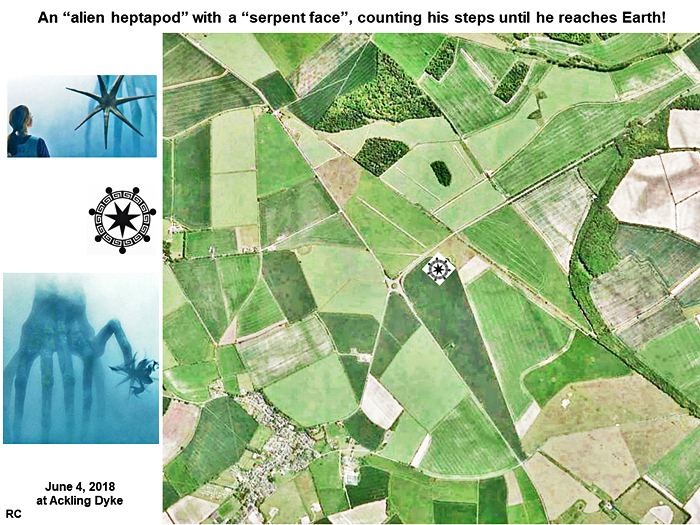
Just like
out of a science-fiction movie “The Arrival” in 2016. What a joker our
friend the crop-artist seems to be! The number of “steps” being taken by
the landscape figure there would appear to be “two” on the ground, with
another step “three” coming soon.
For more
information about the legendary Quetzalcoatl or Kukulkan, please see
rexresearch.com or
he-walked-the-americas or
www.bluffton.edu).
Red Collie
(Dr. Horace R. Drew) |